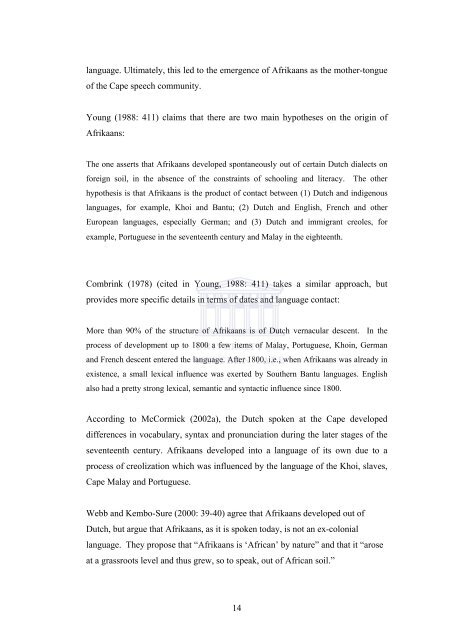grammatical constraints and motivations for - University of the ...
grammatical constraints and motivations for - University of the ...
grammatical constraints and motivations for - University of the ...
You also want an ePaper? Increase the reach of your titles
YUMPU automatically turns print PDFs into web optimized ePapers that Google loves.
language. Ultimately, this led to <strong>the</strong> emergence <strong>of</strong> Afrikaans as <strong>the</strong> mo<strong>the</strong>r-tongue<br />
<strong>of</strong> <strong>the</strong> Cape speech community.<br />
Young (1988: 411) claims that <strong>the</strong>re are two main hypo<strong>the</strong>ses on <strong>the</strong> origin <strong>of</strong><br />
Afrikaans:<br />
The one asserts that Afrikaans developed spontaneously out <strong>of</strong> certain Dutch dialects on<br />
<strong>for</strong>eign soil, in <strong>the</strong> absence <strong>of</strong> <strong>the</strong> <strong>constraints</strong> <strong>of</strong> schooling <strong>and</strong> literacy. The o<strong>the</strong>r<br />
hypo<strong>the</strong>sis is that Afrikaans is <strong>the</strong> product <strong>of</strong> contact between (1) Dutch <strong>and</strong> indigenous<br />
languages, <strong>for</strong> example, Khoi <strong>and</strong> Bantu; (2) Dutch <strong>and</strong> English, French <strong>and</strong> o<strong>the</strong>r<br />
European languages, especially German; <strong>and</strong> (3) Dutch <strong>and</strong> immigrant creoles, <strong>for</strong><br />
example, Portuguese in <strong>the</strong> seventeenth century <strong>and</strong> Malay in <strong>the</strong> eighteenth.<br />
Combrink (1978) (cited in Young, 1988: 411) takes a similar approach, but<br />
provides more specific details in terms <strong>of</strong> dates <strong>and</strong> language contact:<br />
More than 90% <strong>of</strong> <strong>the</strong> structure <strong>of</strong> Afrikaans is <strong>of</strong> Dutch vernacular descent. In <strong>the</strong><br />
process <strong>of</strong> development up to 1800 a few items <strong>of</strong> Malay, Portuguese, Khoin, German<br />
<strong>and</strong> French descent entered <strong>the</strong> language. After 1800, i.e., when Afrikaans was already in<br />
existence, a small lexical influence was exerted by Sou<strong>the</strong>rn Bantu languages. English<br />
also had a pretty strong lexical, semantic <strong>and</strong> syntactic influence since 1800.<br />
According to McCormick (2002a), <strong>the</strong> Dutch spoken at <strong>the</strong> Cape developed<br />
differences in vocabulary, syntax <strong>and</strong> pronunciation during <strong>the</strong> later stages <strong>of</strong> <strong>the</strong><br />
seventeenth century. Afrikaans developed into a language <strong>of</strong> its own due to a<br />
process <strong>of</strong> creolization which was influenced by <strong>the</strong> language <strong>of</strong> <strong>the</strong> Khoi, slaves,<br />
Cape Malay <strong>and</strong> Portuguese.<br />
Webb <strong>and</strong> Kembo-Sure (2000: 39-40) agree that Afrikaans developed out <strong>of</strong><br />
Dutch, but argue that Afrikaans, as it is spoken today, is not an ex-colonial<br />
language. They propose that “Afrikaans is ‘African’ by nature” <strong>and</strong> that it “arose<br />
at a grassroots level <strong>and</strong> thus grew, so to speak, out <strong>of</strong> African soil.”<br />
14
















